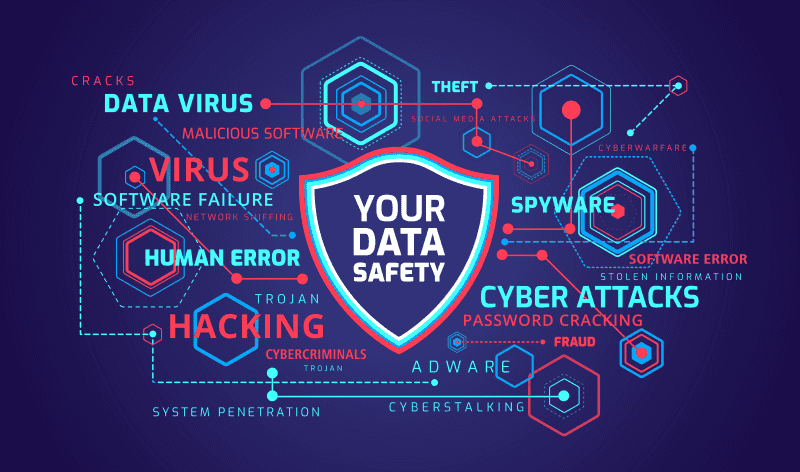
“Cyber security” and “network security” are so frequently used seemingly interchangeably that it can be difficult for a layperson to discern the difference. There are meaningful distinctions, however, and understanding them will help you to ensure your information is as secure as possible in every situation. In fact, both fall under the umbrella of information security.
Cyber Security
Cyber security is a subgroup of information security and it refers to a system that defends an organization’s device and server information. It acts as an extra layer of protection against cyber criminals. It shields the information that is stored in the servers as well as devices.
This type of information security covers the entire defense of digital data. It can protect anything in the cyber domain against cyber crime and cyber fraud attacks. It deals with the protection of the data as it is at rest. Safeguarding sensitive information, online authentication, and up-to-date data are all instances of cyber safety measures.
Network Security
Network security is a subgroup of cyber security. It is a feature that defends information as it travels through and across an organization’s network. It, therefore, guards firm information against despicable personnel who are not sanctioned to view specific sensitive data. It protects the information flowing on the network at the terminal.
Network security ensures protection during the transfer of information only. It protects everything in the cyber domain, dealing with defense from viruses, DOS attacks, worms, and ransomware. Multi-factor authentication, software updates, and rigorous password guidelines are all critical components of network security.
The Critical Difference
The most important thing to understand is that having cyber controls in place is not a replacement for network security or vice versa. If you have stored information and also transfer information, you need controls, policies, plans, and protection in place for both cyber and network security.
How Do You Know If You’re Protected?
A comprehensive, multi-pronged approach to security is the key to preventing devastating attacks. Ramping up basic cybersecurity activities like patching, MFA, least privileged access, network segmentation, and limiting outbound traffic from your server infrastructure are very effective in stopping ransomware, DDOS, and other cyber attacks.
Ensuring that you have complete network visibility to anomalous behavior will allow you to take quick action as well as monitor workstations for command and control activities.
RAVENii urges that organizations of all sizes implement these types of services:
- SOC as a Service (SOCaaS) delivers powerful threat detection, incident response, and compliance management with 24/7 monitoring.
- Log Storage to act as a red flag and provide forensic information.
- Vulnerability Management detects and validates patching of any weakness, flaw, or error that could be used to infiltrate your systems.
- Managed Endpoint Protection to prevent unauthorized access.
- Network Security Monitoring for collecting, analyzing, and escalating indicators of potential security threats and to detect and respond to intrusions on computer networks.
- Penetration Testing to simulate cyber attacks against their network and systems to check for exploitable vulnerabilities.
- Firewall Monitoring to ensure optimal performance of the network firewalls.
- Security Awareness and Phishing Training to fortify the human firewall of your employees.
- Backup Management to ensure fast recovery from human error, hardware failure, or natural disasters.
- Network segmentation to enable the isolation of an active attack before it can spread over the whole network.
RAVENii’s Virtual Chief Information Security Officer Service
RAVENii’s Virtual Chief Information Security Officer consulting service helps organizations by steering them in the right direction; helping them create and facilitate a full suite of security programs. Our consulting services are proactive – seeking out the gaps where our clients are most exposed by using our rigorous step-by-step methodology. This helps evaluate what’s merely a nominal vulnerability versus what represents a true critical risk to an organization.
“Maturity Modeling” is the process RAVENii uses to identify the “gaps” between where a client’s security posture is currently positioned versus where it “should be” within their business vertical. This process gives our customers the ability to quickly and accurately apply the security resources required to close the gaps… freeing them to focus on their core business operations:
- Identification of priority action items to close gaps quickly
- Actionable data for a proactive plan
- Strategic Roadmaps with Level of Effort (LOE)
- Consistent and meaningful metrics
- Maturity modeling gaps to help show business context
- Risk methodology to compare to peers
RAVENii’s team of experts includes former CISOs in the financial, healthcare, manufacturing, transportation, and utility industries.
RAVENii’s vCISO program is customized to serve your security needs and could include the following:
- vCISO Consulting
- Security and Network Assessments
- Vulnerability Assessments – Internal and External
- External and Internal Application Testing
- Wireless Security Assessments
- Social Engineering
- Transaction Security
- Security Program Evaluation
- Security Program Development
- Vendor Management Program
- Regulatory and Compliance Issues
- Critical Security Controls
- GLBA/Banking IT Controls
- PCI - External Vulnerability Assessments
For more information about cyber and network security solutions from RAVENii in Kansas City and nationwide, click here or call (844) 317-0944 today.